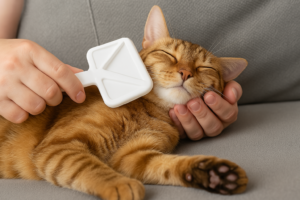Seeing your cat losing hair can be alarming. Maybe you’re finding tufts of fur on the floor or noticing patches of missing hair on your cat’s body. But how do you know if it’s something serious?
Hair loss in cats can be completely normal, especially during seasonal shedding. But in other cases, it may be a sign of stress, allergies, or underlying health issues. Knowing the difference between natural shedding and something more serious can make all the difference in your cat’s well-being.
Is It Normal for Cats to Shed Hair?
Yes. Shedding is a natural process for cats. They shed fur all year round, but more heavily in the spring and fall. This type of hair loss is usually even and doesn’t result in bald spots.
However, if the hair loss is excessive, localized, or comes with itching, red skin, or changes in behavior, it could be a warning sign that your cat needs medical attention.
Top Causes of Hair Loss in Cats
There are several reasons why a cat might lose hair beyond normal shedding. Let’s take a closer look at the most common ones:
1. Stress or Anxiety
Cats under stress may develop psychogenic alopecia, a condition where they compulsively lick certain areas, leading to bald patches.
2. Allergies
Food allergies, flea bites, or environmental allergens like cleaning products can trigger itching and fur loss.
3. Parasites
Infestations with fleas, mites, or ticks can irritate your cat’s skin, prompting excessive scratching and hair loss.
4. Skin Infections
Bacterial or fungal infections such as ringworm may cause circular patches of missing hair and scaly skin.
5. Hormonal Imbalances
Conditions like hypothyroidism or adrenal disease can lead to symmetrical hair loss and changes in skin texture.
6. Poor Diet
A nutrient-deficient diet lacking protein, omega-3s, and vitamins can weaken your cat’s coat and lead to shedding.
7. Chronic Illness
Diseases such as kidney disease, liver issues, or diabetes may cause your cat to lose fur, particularly in the later stages.
When Is Hair Loss a Sign of Trouble?
Watch for these warning signs, which suggest that your cat’s hair loss could be a health issue:
- Visible bald patches or uneven shedding
- Constant scratching or licking of the same area
- Red, inflamed skin or scabs
- Changes in behavior, such as irritability or hiding
- Sudden or severe hair loss unrelated to seasonal shedding
If you notice any of these symptoms, it’s time to schedule a veterinary appointment.
How Is Hair Loss Diagnosed in Cats?
A vet will begin by asking questions about your cat’s medical history and lifestyle. Common diagnostic methods include:
- Full dermatological examination
- Skin scraping to check for mites or fungus
- Blood tests to detect hormonal or metabolic conditions
- Elimination diets if food allergies are suspected
Never self-diagnose or change your cat’s diet without veterinary guidance. Doing so may worsen symptoms or delay proper treatment.
Treatment Options for Cats Losing Hair
The right treatment depends on the root cause. Here are the most common solutions:
- Parasite control for fleas, mites, or ticks
- Prescription diets for allergies or nutritional deficiencies
- Antifungal or antibiotic medication for infections
- Omega-3 supplements to support coat and skin health
- Stress-relief therapies, such as calming sprays or behavior modification
Always follow your vet’s instructions closely—even if the fur starts growing back, it’s important to complete the full course of treatment.
Daily Habits to Keep Your Cat’s Coat Healthy
These simple routines can help reduce excessive shedding and promote a shiny, healthy coat:
- Brush your cat regularly, especially if they have long fur
- Feed a balanced, high-quality diet appropriate for their life stage
- Minimize environmental stress by keeping a calm, stable routine
- Use flea preventatives even for indoor-only cats
- Ensure constant access to clean water to support skin hydration
How Long Does It Take for Hair to Grow Back?
For mild cases, hair may begin to regrow within a few weeks of addressing the cause. In more serious conditions, regrowth could take several months. Your vet will monitor progress and adjust treatment if needed.
FAQs – Common Questions About Cats Losing Hair
Is daily hair loss normal for cats?
Yes, especially during seasonal changes. Excessive or uneven hair loss, however, needs investigation.
Can bathing my cat cause hair loss?
No, but using the wrong shampoo or bathing too often can irritate the skin and worsen shedding.
Do neutered cats lose more hair?
Hormonal changes after neutering may affect coat condition, but significant hair loss is not typical.
Could my cat be stressed?
Yes. Overgrooming, behavioral changes, or hiding can all be signs of stress-related hair loss.
Informative Video on Cat Hair Loss
For a visual explanation of the common reasons for cat hair loss and their treatments, watch the following video:
Source: [Top 5 Reasons for Cat Hair-Loss! | Vet Explains Treatments](https://www.youtube.com/watch?v=d53GX9Bh5lo)
Final Thoughts: Know When to Take Action
If you notice your cat losing hair, don’t panic—but don’t ignore it either. Identifying what’s normal and what’s not is key to protecting your cat’s health. Early detection leads to quicker recovery and prevents complications.
👉 Also read: Important Tips for Cats’ Skin Care
Found this guide helpful? Share it with fellow cat owners and explore our site for more tips on feline health, nutrition, and grooming. Your cat deserves the best care, every day.



